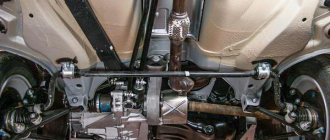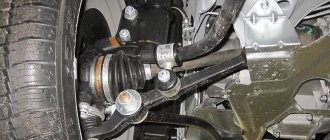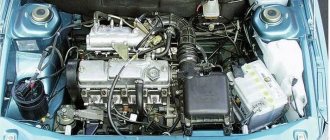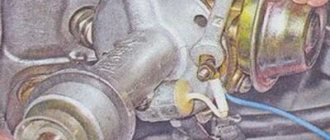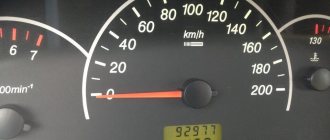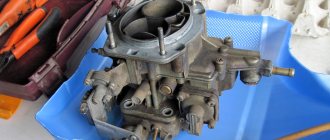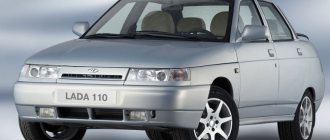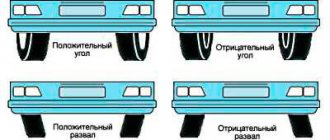The rear suspension is dependent, with 12 coil springs and 10 double-acting hydraulic telescopic shock absorbers.
The main load-bearing element of the suspension is a beam consisting of trailing arms 14 and a connector 13, welded together through reinforcements.
At the rear, brackets 15 with eyes for attaching shock absorbers 10 and flanges for attaching the rear wheel axles and brake shields are welded to the suspension arms.
At the front, the levers 14 are equipped with welded bushings with silent blocks 3 pressed into them. A bolt passes through the central bushing of the silent block, connecting the lever to the bracket 2.
To attach the bracket to the body side member, three welded bolts are provided.
The suspension spring 12 rests with its lower end on a cup welded to the shock absorber reservoir, and with its upper end, through a rubber gasket 11, on a support welded from the inside to the body arch. The lower eye of the shock absorber is bolted to bracket 15 of the suspension arm, and its rod is secured to the upper support of the suspension spring through two rubber pads 8 (one at the bottom of the support, the other at the top) and a support washer 7 (under the nut).
The hub has a double-row angular contact ball bearing, similar to the front wheel hub bearing, but smaller.
The bearing fit on the axle is transitional (with slight interference or clearance).
During operation, the bearing does not require adjustment or replenishment of lubricant. It is not allowed to eliminate the resulting play by tightening the nut; the bearing should be replaced.
When the hub is pressed out, the bearing is destroyed, so it is not recommended to disassemble the hub if the bearing is in good condition.
Rear beam device
The metal rear beam, a photo of which is presented on our resource, is structurally represented by 2 longitudinal levers and connection elements, which are connected by welding through reinforcement components. At the rear of the product there are special holders with holes for mounting shock-absorbing elements. There are also flanges with holes for fastening the axles of the rear wheel pair together with the casings of the stern brake systems.
In the front part of the rear axle beam of the VAZ 2110 there are levers with welded bushings, in which rubber-metal type hinges are installed by pressing. The rear beam mounts pass through them, which connect the lever part of the stern suspension to stamped-welded type holders. Those, in turn, are mounted with welded bolts to the body side members.
The spring elements of the suspension rest with one plane on the support of the shock absorber strut, and with the other, through a rubber insulating gasket, into the welded support of the hidden arch of the body tail. The shock absorber strut of the rear suspension beam of the VAZ 2110 is a hydraulic telescopic system of a two-way operating principle.
Through fasteners in the form of a bolted connection, it is articulated with the holder of the longitudinal-type stern suspension arm. The upper fastener of the rack is made in the form of a pin connection, while the fastening of the rod to the upper support is made through rubber pads and a support washer.
The factory “tens” rear beam, the dimensions of which differ from the parameters of similar products, has the item number 2110-2914008, while the “eight” beam has the catalog number 2108-2914008-10.
Garage or service station
All car enthusiasts can be divided into two categories:
- Those who do most of the repairs independently in their garage, and only in critical cases turn to a car service;
- Those who prefer not to touch anything with their own hands, but 100% trust repairs and services to service station technicians.
Any of their rights in their own way. Therefore, we have no right to reproach those who do not want to do repairs without the help of others. After all, garage and professional repair of silent blocks, like other components, has its advantages.
100 has the following advantages:
- A high-quality, responsible car service provides a guarantee for the repairs performed;
- In case of repeated breakdown, which is covered by the warranty, repairs will be carried out free of charge;
- Masters are masters, they have vast experience and knowledge, which allows them to do their job well.
But first you need to find such a car service, which, alas, is not an easy matter. Many give a guarantee, but when they call again, they do everything possible to justify the failure of the failure to comply with the terms of the guarantee. An obvious ploy.
Repairing your garage will provide the following benefits:
- Significant money savings, since you only have to spend money on consumables;
- The quality of work performed by a craftsman is always in doubt if you do not understand this person personally. So self-repair may be much better than 100;
- You purchase the silent block, and the master only installs it. Why pay money for work that you can do yourself?!;
- Guarantee that a new one will be installed instead of the old silent block. Incomprehensible 100 can, without any problems, install an old, more or less usable silent block instead of the one you gave them. You yourself realize what the result is.
Removing and installing the rear beam and its elements
If during the operation of the vehicle the rear suspension beam of the VAZ 2110 bursts, then in the future it will need to be replaced. Of course, as a temporary aid, it can be restored by welding. But this is done solely in order to get to the maintenance site where it needs to be replaced.
Operating a vehicle with a welded beam rear suspension of the VAZ 2110 not only creates an emergency situation on the road, but also leads to disruption of vehicle stability and accelerated wear of the vehicle tires. The market value of the rear beam is quite high, but its replacement in this case is simply necessary.
We replace a product such as a rear beam, which can be purchased at any specialized automotive store, according to the following scenario:
- We place the vehicle on an electric lift or a special repair pit.
- We remove the brake pads from the rear wheels and release the hand brake cables from the rear beam and holders.
- We remove the brake pipes from the rear cylinders, and the hoses from the stern beam.
- We remove the drive-type pressure regulator fasteners from the stern beam.
- Remove the 4 bolts securing the hub axle to the aft beam using a wrench set to “17”.
- We dismantle the hub axle together with the brake mechanism casing.
- Having removed the fastening bracket, we dismantle the brake system pipe.
- If the need arises, we disconnect the hub axle and the brake mechanism housing, while freeing 2 screws with a curly screwdriver.
- We detach the lower fasteners of the shock absorbers from the rear beam.
- Remove the fasteners of the rear suspension beam to the holders.
- Place the rear beam on the ground.
- Having removed the fasteners, we dismantle the product.
- We remove the fasteners of the holder to the bodywork and dismantle the bracket.
- Installing the rear suspension component is carried out in the reverse order.
- We complete the fastening of the rear beam and the lower part of the shock absorber struts with the vehicle installed on the site.
- We finish the job by bleeding the brake system.
Selecting New Items
To replace and ensure reliable operation of the car, you need to purchase excellent silent blocks. It’s easy to choose them if you know certain aspects:
- For the VAZ 2110 model, elements with catalog number 2110 2914054 are suitable. They have the required external diameter corresponding to this specific VAZ model;
- Do not try to purchase a silent block from a 9 and install it on your 10. Nothing will come of similar events, no matter what anyone says;
- Make sure of the quality of the products. Low-grade silent blocks have flooded the market, but their service life leaves much to be desired. Excellent parts made from quality materials that can withstand extreme loads and temperatures.
Removing the rear suspension beam VAZ 2110,2111,2112 – watch video online in My World
My homeland))))) Super top 106,497 11/24/2017 Well, we parted ways) Super top 77,488 11/24/2017 Multi-colored lakes) Super top 12,450 11/24/2017 How to get close to a chicken unnoticed) Super top 23,626 11/24/2017 Fable. Dog and an inverted cup) Super top 14,820 11/24/2017 Meeting of accordionists) Super top 8,692 11/24/2017 Baby gecko) Super top 7,378 11/24/2017 When you're tired of dieting))) Super top 5 901 11/24/2017 When you prepare food according to a recipe bloggers) Super top 4,926 11/24/2017 When you're in a video game) Super top 4,145 11/24/2017 When you forget basic things) Super top 4,543 11/24/2017 When you don't want to part with something you love) Super top 4,495 11/24/2017 Oops ) Super top 4,002 11/24/2017 Start and continue) Super top 3,166 11/24/2017 Positive)) Super top 2,975 11/24/2017 Little children and a dog are completely positive Super top 2,406 11/24/2017 Children and dolphins. Super top 1,729 11/24/2017 And everyone would think a UFO) Super top 1,757 11/24/2017 The last waltz of autumn Super top 1,039 11/24/2017 Extract from the maternity hospital. This needs to be seen and heard Super top 1,737 11/24/2017 A stubborn puppy and a treadmill Super top 1,568 11/24/2017 A child eats to the beatbox rhythm Super top 1,746 11/24/2017 A husband needs it Super top 1,480 11/24/2017 Italians' reaction to Yeralash Super top 933 11/24/2017 Gorilla adopted a boy Super top 1 902 11/24/2017
Removal and installation of the rear beam VAZ 2110, VAZ 2111, VAZ 2112
Rear beam Installation and repair of the rear suspension of VAZ 2110, VAZ 2111, VAZ 2112 do-it-yourself chassis repair rear suspension, do-it-yourself check, repair
We carry out the work on an inspection ditch or a lift.
We remove the rear brake pads of the VAZ 2110 and disconnect the parking brake cables from the rear suspension beam and brackets. Disconnect the brake pipes from the rear brake cylinders, and the rear brake hoses from the beam. We disconnect the elastic lever of the pressure regulator drive from the beam (see chapter Brake system VAZ 2111).
Using a 17mm wrench, unscrew the four bolts securing the hub axle to the rear suspension beam.
We remove the hub axle together with the brake shield of the VAZ 2111.
Having unbent the fastening bracket, remove the brake pipe.
If necessary, separate the hub axle and the brake shield by unscrewing two screws with a Phillips screwdriver.
Brake shield and hub with axle
We disconnect the lower ends of the shock absorbers from the VAZ 2111 beam (see Removing the shock absorber and spring). We unscrew the nuts of the bolts securing the beam to the brackets (see Replacing silent blocks of the rear suspension of a VAZ 2110).
We lower the beam.
After removing the bolts, remove it.
Using a 17mm socket, unscrew the three nuts securing the bracket to the body of the VAZ 2112.
. and remove it.
Install the beam in reverse order. We tighten the bolts securing the beam and the lower ends of the shock absorbers in the “car on wheels” position. After this, we bleed the hydraulic brake drive of the VAZ 2112 (see Bleeding the brakes).
Rear suspension of VAZ 2110, VAZ 2111, VAZ 2112
Rear suspension design
Rear suspension of VAZ 2110, VAZ 2111, VAZ 2112
Why change silent blocks
Before you begin replacing the silent blocks of the rear beam on the VAZ 2110, you need to figure out why a similar procedure is being carried out in general.
In reality, it is not always silent blocks that cause car problems. But there are situations in which repairs should be performed immediately.
- When traveling, the tires begin to squeak. If the silent blocks are out of order, they cannot move at once with the wheels, they are inferior in rotation speed, which is why noise appears.
- Knocks are heard from the rear of the car.
- The car is difficult to control, the rear end constantly wobbles, and it is difficult to take turns.
- There is uneven wear on the rear tires; they lose their quality faster than the front tires.
- In some cases, tires are deflated, although there is no damage.
A lightweight method for replacing the silent blocks of the rear beam of a VAZ
2108, 2109, 21099,
2110
, 2111, 2112, 2113, 2114, 2115.
Replacement of silent blocks of the rear beam of VAZ 2108-2115
Repair of VAZ 2110 (Lada) Replacement of the rear suspension beam
- Repair manuals
- Repair manual for VAZ 2110 (Lada) 1996+.
- Replacing the rear suspension beam
4.2.4. Replacing the rear suspension beam
If, after removing the beam, you intend to disassemble it, first loosen the tightening of the wheel bolts and hub nuts.
| ArcheologyArchitectureAstronomyAuditBiologyBotanyAccountingMilitaryGeneticsGeographyGeologyDesignArtHistoryCinemaCookingCultureLiteratureMathematicsMetallurgyMythologyMusicPsychologyReligionSportsConstructionTechnologyTransportTourismEstatePhysicsPhotographyChemistryEcologyElectricityE electronicsenergy | 4.1 Rear beam structure The rear suspension beam for cars of the VAZ 2110 family consists of two longitudinal arms 13 (Fig. 1) and a connector 12, which are welded together through amplifiers. In the rear part, brackets 14 with eyes for attaching shock absorbers are welded to the suspension arms, as well as flanges 15, to which the rear wheel axles are bolted together with the wheel brake shields. At the front, the suspension arms have welded bushings 16 into which rubber-metal hinges 1 are pressed. Bolts pass through the hinges connecting the suspension arms to stamped-welded brackets 2, which are attached to the side members of the car body VAZ 2110, VAZ 2111, VAZ 2112 with welded bolts. Springs 11 (see Fig. 1) of the suspension rest with one end on the shock absorber cup 9, with the other, through an insulating rubber gasket 10, in a support welded to the inner arch of the body of the VAZ 2110 family of cars. The rear suspension shock absorber of the VAZ 2110 family of cars is hydraulic, telescopic, double-sided actions. It is attached with bolt 9 (Fig. 2) to the trailing arm suspension bracket of the VAZ 2110 car. The upper shock absorber mounting is pin-type: the rod is attached to the upper support 5 of the suspension spring through rubber cushions 6 and support washer 3. The shock absorber parts are shown in Fig. 3. In hub 13 (see Fig. 2) there is a double-row angular contact bearing 12, similar to the front wheel hub bearing, but smaller in size. Unlike the front wheel hub, where the inner bearing ring is installed on the hub with guaranteed interference, bearing 12 on axle 14 has a transitional fit. Fig.1. Rear suspension parts: 1 – rubber-metal hinge; 2 – suspension arm mounting bracket; 3 – shock absorber casing; 4 – compression stroke buffer; 5 – casing cover; 6 – support washer; 7 – shock absorber cushion; 8 – spacer sleeve; 9 – shock absorber; 10 – insulating gasket; 11 – rear suspension spring; 12 – lever connector; 13 – lever of the rear suspension beam; 14 – shock absorber mounting bracket; 15 – flange; 16 – lever bushing | Rice. 2. Shock absorber mounting: 1 – protective casing; 2 – compression progress buffer; 3 – support washer; 4 – spring insulating gasket; 5 – upper support cup of the suspension spring; 6 – shock absorber rod mounting pads; 7 – lower spring support cup; 8 – shock absorber; 9 – shock absorber mounting bolt; 10 – wheel hub axle mounting bolt; 11 – brake drum; 12 – hub bearing; 13 – wheel hub; 14 – axis; 15 – nut; 16 – retaining ring; 17 – locating pin | Rice. 3. Rear suspension shock absorber parts: 1 – recoil valve nut; 2 – recoil valve spring; 3 – recoil valve plate; 4 – washer; 5 – recoil valve disc; 6 – throttle disk of the recoil valve; 7 – piston; 8 – piston ring; 9 – bypass valve plate; 10 – bypass valve spring; 11 – limit plate; 12 – spacer sleeve; 13 – reservoir; 14 – rod; 15 – compression buffer support; 16 – nut; 17 – oil seal cage; 18 – rod protective ring; 19 – oil seal; 20 – sealing ring of the tank; 21 – rod guide bushing; 22 – cylinder; 23 – compression valve cage; 24 – intake valve spring; 25 – compression valve plate; 26 – throttle disk of the compression valve; 27 - compression valve discs; 28 – compression valve body; 29 – rubber-metal hinge |
When replacing worn rubber-metal hinges of the rear suspension beam arms, special tools and skill are required, so it is recommended to replace the hinges in a specialized workshop.
| EXECUTION ORDER |
| 1. Remove the rear suspension shock absorbers on both sides of the car (see subsection 4.2.2). | |
| 2. Disconnect the parking brake cables from the equalizer, remove the shells of both cables from the bracket on the body, bend two brackets securing each cable to the body and remove both cables from the rear suspension beam mounting brackets, for easy access to the beam mounting bolt (see subsection 6.10 .3). | |
| 3. Disconnect the elastic arm of the pressure regulator drive from the bracket on the rear suspension beam (see subsection 6.4.1). | |
| 4. Disconnect one brake hose on both sides from the tubes on the rear suspension beam. Plug the hose holes. | |
| 5. Unscrew one nut on both sides of the bolts securing the beam to the brackets, knock out the bolts and remove the beam by rolling it out from under the car on wheels. | |
| Recommendation | |
The manufacturer recommends removing the beam together with the brackets by unscrewing three nuts securing them. However, after prolonged use, rusted studs may break. Therefore, it is better to remove the beam by disconnecting it from the brackets that remain on the body.
Finally tighten the nuts of the beam mounting bolts with the vehicle standing on the ground. After installation, bleed the brake system and adjust the parking brake. Download information from the page
Replacing silent blocks
If squeaks and extraneous noises occur in the car, it is necessary to replace worn parts. This will help avoid more significant breakdowns that will lead to complex and expensive repairs.
The first thing you need to pay attention to when checking the performance of beams is the silent blocks. They are replaced using a special puller made using several sections of pipes to which washers are welded
If you do not want to spend extra time on manufacturing, purchase the device at any specialized store. The rear wheels must be secured using shoes specially adapted for this procedure or ordinary bricks. This must be done because the car, raised with a jack, can jump off it and crush you.
Remove the raised wheel and check how loose the silent blocks are in the beam arm. If they are loose, repairs will need to be made. Unscrew the upper support nut and, applying short blows to the bipod, turn out the wheel. The blows must be applied until the support pops out. Then unscrew the long bolt, which is located at the top of the lever, and proceed to directly inspect the silent blocks of the front beam.
They must be knocked out with strong blows of the hammer on the chisel. They pop out of the grooves with ease after the first successful hit. In order to obtain greater sliding ability, first clean the old socket. After this, all parts are moistened with a soap solution, and the new silent block is pressed into place of the old one using the pressing method. Please note: after you press in, there should be no play at all, otherwise the repair of the front beam will be in vain.
Replacing the silent blocks on the lower beam will require much more effort. First of all, turn off the stabilizer so that the lever can move freely. Unscrew all the nuts that hold it in place and knock them out in the same way as when replacing the front beam. After you press in the new silent block, the replacement can be considered complete.
